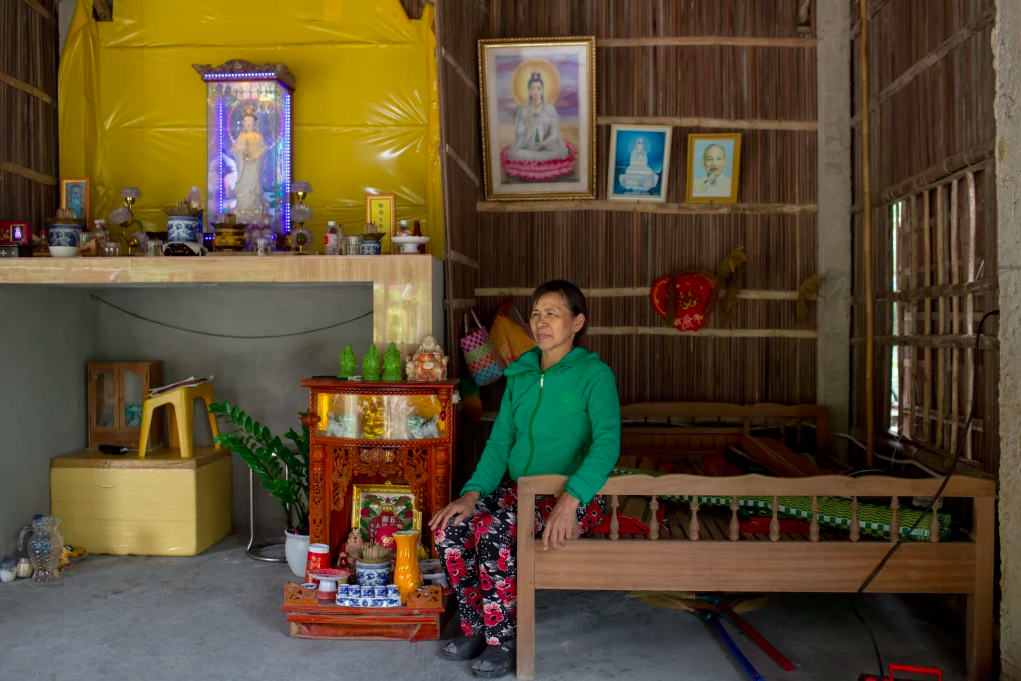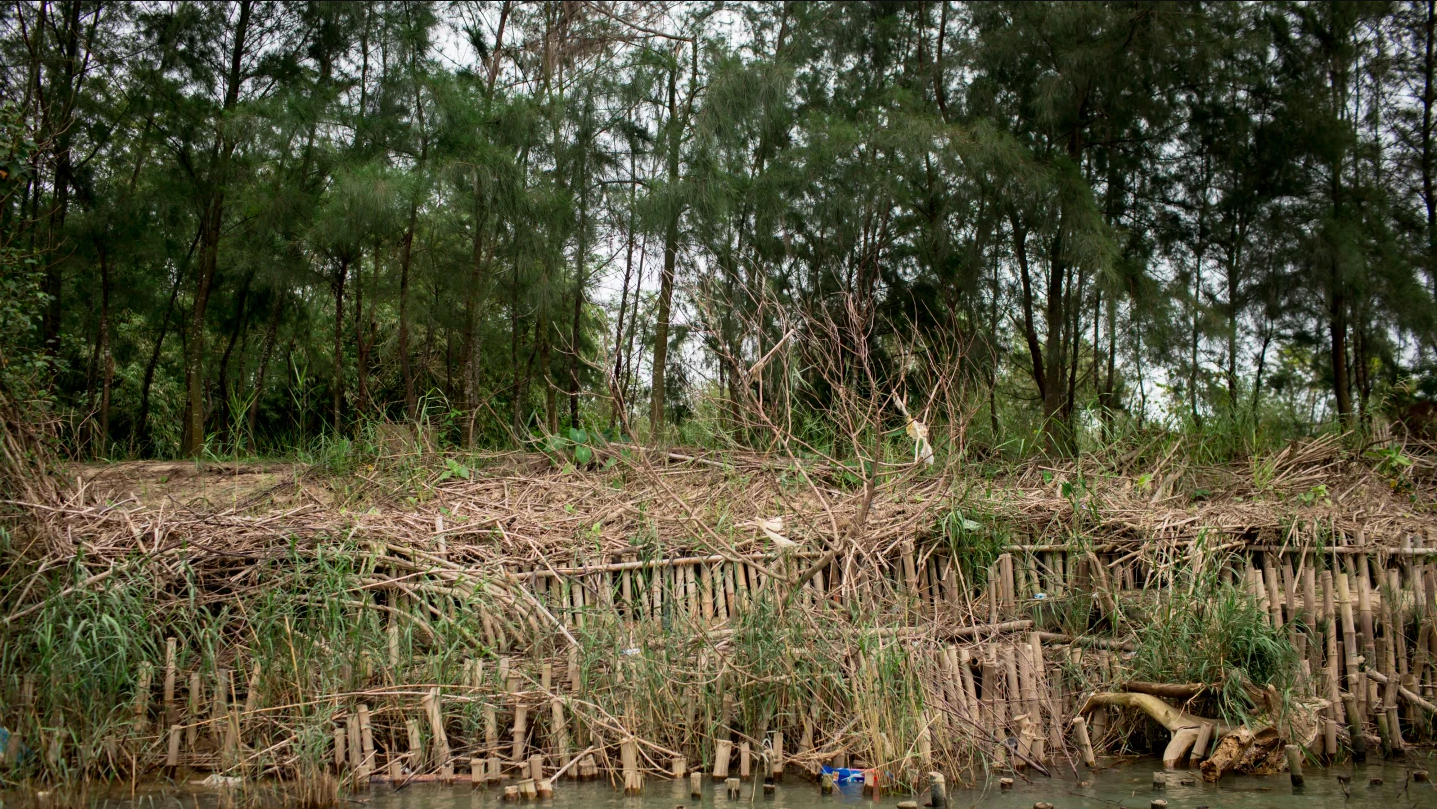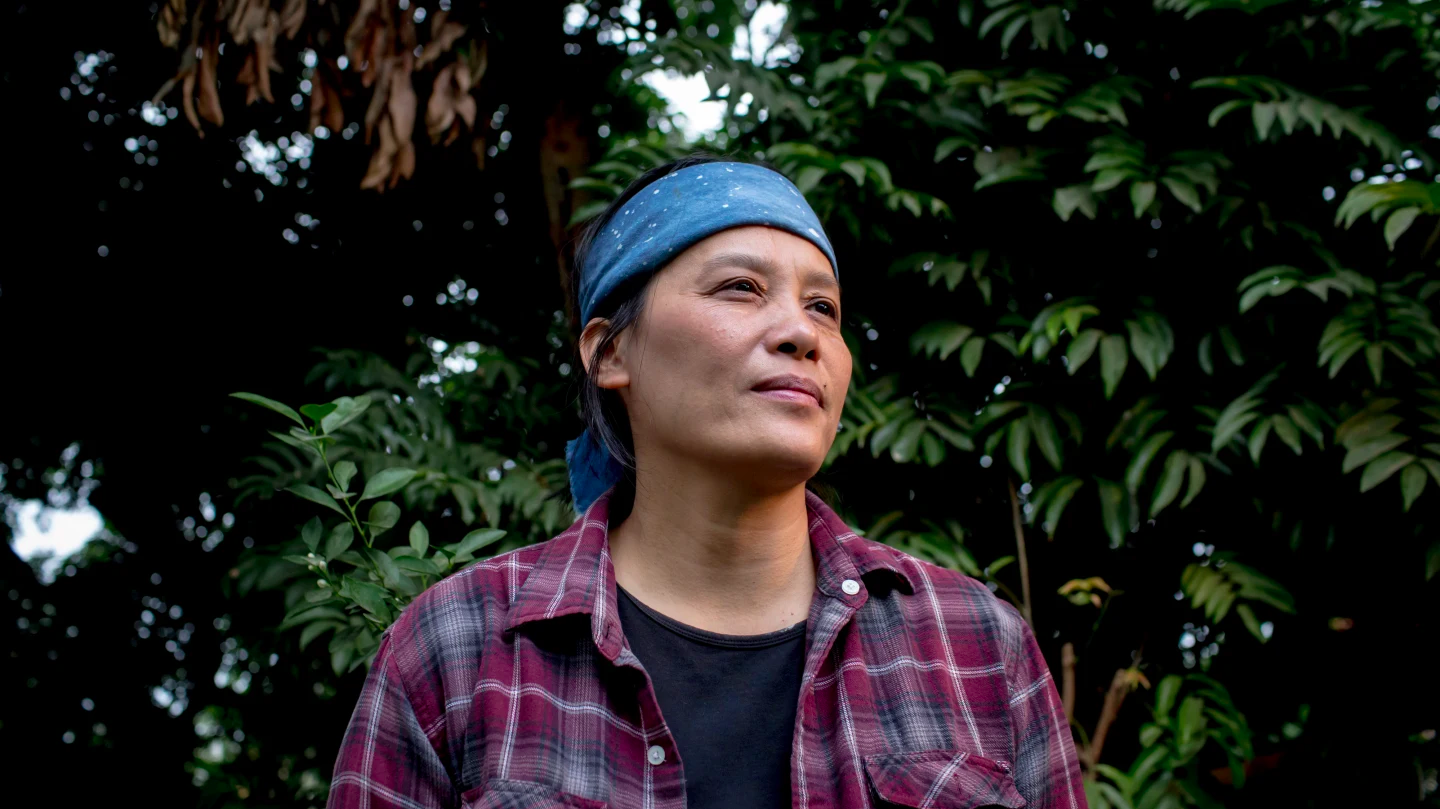The project Rethinking Reforestation in Vietnam From Community-Led Perspectives began this year as a collaboration between Southeast Asia Rainforest Journalism Fund grantee Lam Le and photojournalist Yen Duong, also a Southeast Asia RJF grantee. Both Le and Duong interviewed and photographed grassroots community leaders, and talked with them about their efforts to address floods and other natural hazards in rural Vietnam.
“Lam Le and Yen Duong’s reporting, deeply rooted in rural Vietnamese communities, highlights how local knowledge is at the heart of long-term sustainability. A mangrove replanting effort may not be a flashy or new technology, but it is the result of trial and error and dutiful caretaking across generations. Local communities understand what works and what doesn’t, and they have a vested interest in preserving both their ecosystem and their economy. The Rainforest Journalism Fund is proud to support innovative journalism that shows what can be gleaned when embracing rather than confronting nature,” said Leonor Grave, the Rainforest Journalism Fund assistant.
Rainforest Journalism Fund Intern Kymberley Chu spoke with Le and Duong about the Rethinking Reforestation project.
Both Le and Duong reflected on the promising power of mangrove restoration and the significance of their published stories within the greater Vietnamese media landscape. This interview has been edited for length and clarity.
Kymberley Chu: So this is more of a collaborative journalism project, right? What did you report on?
Lam Le: Most of the initiatives are grassroots in central Vietnam, on reforestation, these are small projects. But people were usually smaller communities and grew mangrove forests. It came out of coastlines from storms, and typhoons because central Vietnam is very sensitive. It's an area that is highly prone to natural disasters like storms and typhoons every year. There's been intense erosion in the area for as long as I remember. There are several of these kinds of small-scale mangrove projects growing there to first protect the coastline, but also over time, they became a kind of a livelihood for the communities.

Le Thi Huong, 59, a mangrove palm farmer, in her home made from the palms in Cam Thanh commune. Image by Yen Duong. Vietnam, 2021.
KC: How did you find out about the stories you were reporting? What made you decide to report on these local community initiatives?
LL: There are several substories here. One story is from an acquaintance of mine. Dr. Dao [Ngo], whom I quoted in the stories, I've known her before, and I've known about her project. I found it very interesting, and the other initiatives I gathered from local media and talking to local authorities such as Hoi An's deputy chair. The third story feature I got by attending a conference on climate change and reforestation. There, I met this government official and they informed me there's a reforestation project in this area.
KC: What did you learn from reporting these experiences? What do you want your audience to think about as you report these stories?
Yen Duong: I worked as a photojournalist, and I've covered natural disasters before. I cover heavy floods, and landslides, which is why I'm also very interested in this project and wanted to collaborate with Lam. At one point, we talked and we realized, a lot of the narratives that we've seen in the media focus a lot on losses and on sufferings. There is not so much on how to actually improve the conditions for people living there [natural disaster-affected areas]. It's also hard for me as a photojournalist to constantly photograph it, because we have natural disasters in Vietnam, every year, and the issue is very visible within the government's political agenda as it's causing a lot of damage. I was very fascinated also when Lam told me about this initiative that Dr. Dao [Ngo] was implementing because it offers specific solutions. At that time, we both were actually looking for solution-oriented stories. My takeaway would also be that this story gave us hope that it is actually possible to do something about natural disasters. I think that it's also kind of important to do more solution-based stories that actually can help local residents, instead of just reporting about natural disasters.

Remnants of An Nhien farm's natural embankment damaged by last year’s floods in Triem Tay village. The embankment, designed by Dr Dao Ngo, consists of three layers of Indigenous trees and bamboo biologs. Image by Yen Duong. Vietnam, 2021.
LL: The main awesome message of these stories is that we can assess solutions, as Yen said. Sometimes the solution doesn't have to be very grand, very high-tech, or very elaborate. In this age, we are kind of obsessed with technology, but also technology can be costly. And it's not the only way. All these [mangrove] initiatives, they take a step back, and they don't try to fight the storms. I mean, the storms are really strong and very dangerous. For centuries, we as humans have been trying to conquer nature. But these projects, have this message, why should we conquer nature? We should learn to live with it, because actually, the very act of conquering nature is why we have climate change now, right? Because for every fight, we'll have a reaction from nature, this is like the experience that people that we interviewed showed. The approach in the solutions is to find a middle ground and to live with nature.
KC: Have there been any updates or any more environmental/ecological challenges these initiatives experienced after your stories were published?
YD: I think Lam can explain a little bit about that. At the time that we were actually photographing, it was also at the same time that the initiative was damaged because of the storms that we had in 2020. They were actually rebuilding.
LL: After our reporting trip, the community in Hoi An decided to replant the section of the mangrove forests that got damaged by the storm. Also, they expanded the area with partial funding from the government and partial funding from crowdfunding. So the mangrove forest in Cam Kim Village got extended after our reporting trip. But it wasn't included in this story. For bigger changes, I think I'm curious to see how these initiatives will stand. This year's monsoon season has only started recently, and there are more storms to come for sure, based on what has happened in previous years. So, I'm curious to see how the initiatives will withstand this year's monsoon season.

A corner of a mangrove nipa palm forest in Cam Thanh Commune, Quang Nam Province, January 2021. Image by Yen Duong.
YD: These solutions are long-term-based. You can also not expect to see immediate results. In Dr. Dao’s work, even researching which types of trees [to grow] took a lot of time. And part of the reason why her initiative was damaged by the floods was mainly that the trees require more time to grow. But then the floods came, and they were just too young. It's also very fascinating to see that a lot of the funding that we invest on the state level — usually like building concrete, levee, or things like that — can bring immediate effects. But it can also, in the long term, not really sit well with the environment, which is why it is also a very high risk for this kind of solution project. But at the same time, it is interesting to see how they evolved through time and which is why it fits well with her philosophy, which is to live with the floods, you know, to live with nature.
I wanted to stress that these are more long-term-based solutions, and you will not be able to see immediate results, but we have high hopes for it mainly because of her interesting approach. Also looking at how she works with the communities and even also after the immediate damage from last year's floods, which was very historical in Vietnam, I was also actually covering a natural disaster in the same province. Locals also said they've never seen something like that. It caused damage, but the land was preserved. So it already shows here an effect, even though the levee was damaged.
KC: What I like about journalism is that you can tell different story angles and check in on things as they progress. Why do you think journalism is important?
LL: If we didn't have journalism, the only kind of voices that we would hear would be propaganda and would be voices from people that have power, that is more powerful. So there'll be much fewer voices from all sorts of other walks of life. Then, people wouldn't be aware of a lot of injustices going on. Once people are not aware, then the likelihood of change or preventing injustice from happening would be lower.
YD: I think that journalism is very important in the sense that it offers alternative views from the more official views that we see. Especially in Vietnam, where the journalism climate is very hostile, very different, and very censored compared with other countries in Southeast Asia. I think for me, the relationship with journalism is really complicated, because it's very important in raising alternative perspectives, in talking to people who otherwise would not be heard. I also think it's important we need to reflect on the things we report on. And that kind of self-reflection sometimes doesn't feel like enough in journalism.
The overall picture is it offers certain claims on people who are from marginalized communities, like local communities who especially don't have the access, or they don't have the power to raise their voices. I think that as journalists, it's also a privilege for us to actually talk to them because we don't live in the same environment as them. I think it's just amazing that they allow us access into the communities and to document the stories. In the process, as journalists, we also learn a lot of things from local communities. It's important in that sense and as journalists and photographers, our responsibility is to convey these narratives to our readers.
KC: Why is it important to tell underreported stories, especially in the context of Vietnam?
LL: The underreported stories usually are the ones deemed unimportant or insignificant by higher-up editors or not going to be interesting enough to the mainstream readership. If you look at the mainstream readership of online news, because online is dominated in Vietnam, you'll see that most of them are urban and middle-class-type people. But at least that's the assumption that lots of editors have in Vietnam here. This is why stories about what's happened in rural areas where climate change is already having a huge effect are not reported often enough. Or, if there are stories on climate change, they usually only discuss smaller climate change initiatives; they don't make the link to the broader issue of climate change.
With this lack of stories of what's already happening, climate change-wise, on the ground in rural areas in Vietnam, then the general population is not aware of how serious this issue is. There could be this kind of false sense of safety. A false sense of climate change is some distant thing that's not happening to me because I live in high-rise apartments and am not affected by floods for example. So, it's important to tell these underreported stories for leaders in Vietnam, for example, to have a better understanding of the gravity of the situation, that it's not some distant, dystopian idea that's going to hit sometime in the next 50 years, but it's actually already here.
YD: We actually do have a lot of reporting on climate change, and the effects of climate change on the local communities. What we don't see a lot is coverage on local initiatives. So we have a very conformed or uniform singular narrative when it comes to any particular issue, such as climate change, et cetera. I also notice the same pattern from foreign media covering Vietnam. So we're kind of living in a very polarized media climate when it comes to covering Vietnam.
What I don't see is this discussion on how local communities, such as the stories that we've done, like how they actually came up with their own solutions and tried to do something about it. It is not receiving enough attention and there's a lot of politics around it that makes it so difficult to bring this solutions-based approach to other places in Vietnam that have similar issues. I think that's why it's also important to bring it to the mainstream media in a sense.
KC: What advice do you have for entry-level journalists on reporting underreported stories?
LL: For me, I found personally, that going out of my comfort zone is one way to find interesting story angles. If you want to find something new because I'm an urban-educated person living in a city in the capital. So I'm in a very privileged position, I suppose. For example, I recently started by venturing through very vibrant Facebook groups and other online communities that I'm not part of. Of course, these are open groups that you can go in and see what's going on there. Or, for example, taking advantage of something like TikTok is a very interesting source to find new angles and new stories. We try to get out of our immediate bubbles and talk to the people that are not usually featured in the media.

Dr Dao Ngo bought her own land in Triem Tay village to do her conservation work. Image by Yen Duong. Vietnam, 2021.






